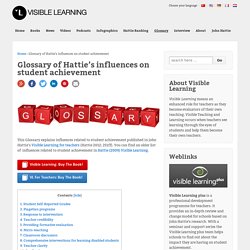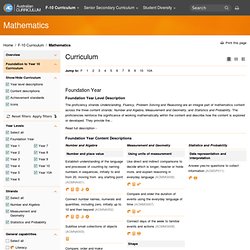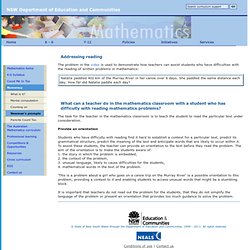

A Maths Dictionary for Kids 2013 by Jenny Eather. Math Concepts & Skills Taught with Fiction & Nonfiction Stories. Tid. Glossary of Hattie's influences on student achievement. This Glossary explains influences related to student achievement published in John Hattie’s Visible Learning for teachers (Hattie 2012; 251ff).

You can find an older list of influences related to student achievement in Hattie (2009) Visible Learning. 1. Student Self-Reported Grades Self reported grades comes out at the top of all influences. Children are the most accurate when predicting how they will perform. Example for Self-reported grades: Before an exam, ask your class to write down what mark the student expects to achieve. Hattie cites five meta-studies: Mabe/West (1982): Validity of self-evaluation of ability (Abstract)Fachikov/Boud (1989): Student Self-Assessment in Higher Education (Abstract)Ross (1998): Self-assessment in second language testing (Abstract)Falchikov/Goldfinch (2000): Student Peer Assessment in Higher Education (Abstract)Kuncel/Crede/Thomas (2005); The Validity of Self-Reported Grade Point Averages, Class Ranks, and Test Scores (Abstract) 2. 3. 4. 5. 6. 7. 8.
Thinking Blocks - Model Math Problems on iPads, Interactive Whiteboards, and in Your Browser. The Australian Curriculum v7.1 Numeracy - Introduction. The Australian Curriculum v7.0 Mathematics Foundation to Year 10 Curriculum by rows. Year 8 Level Description The proficiency strands Understanding, Fluency, Problem Solving and Reasoning are an integral part of mathematics content across the three content strands: Number and Algebra, Measurement and Geometry, and Statistics and Probability.

The proficiencies reinforce the significance of working mathematically within the content and describe how the content is explored or developed. They provide the... Read full description › The proficiency strands Understanding, Fluency, Problem Solving and Reasoning are an integral part of mathematics content across the three content strands: Number and Algebra, Measurement and Geometry, and Statistics and Probability. At this year level: Problem Solving includes formulating, and modelling practical situations involving ratios, profit and loss, areas and perimeters of common shapes, and using two-way tables and Venn diagrams to calculate probabilities Hide full description ›
A Maths Dictionary for Kids 2013 by Jenny Eather. Cool Math Logic Games - Free Online Math and Logic Free Online Math Games, Cool Puzzles, Mazes and Coloring Pages for Kids of All Ages. Newman's prompts. Newman's prompts Finding out why students make mistakes The Australian educator Anne Newman (1977) suggested five significant prompts to help determine where errors may occur in students attempts to solve written problems.

She asked students the following questions as they attempted problems. 1. Please read the question to me. 2. 3. 4. 5. These five questions can be used to determine why students make mistakes with written mathematics questions. Addressing reading. Addressing reading The problem in the video is used to demonstrate how teachers can assist students who have difficulties with the reading of written problems in mathematics: What can a teacher do in the mathematics classroom with a student who has difficulty with reading mathematics problems?

The task for the teacher in the mathematics classroom is to teach the student to read the particular text under consideration. Provide an orientation Students who have difficulty with reading find it hard to establish a context for a particular text, predict its grammatical structure, predict the meaning of the text and anticipate words that are likely to occur within it. 'This is a problem about a girl who goes on a canoe trip on the Murray River' is a possible orientation to this problem, providing a context to it and enabling students to access unusual words that might be a stumbling block.
Math. Math Resources. Teacher Home Page. Maths: Calculations: Addition and Subtraction. Find and Use. Duinanddobber.sfinstructionalresources.wikispaces. The Numeracy Continuum K-10. Aspect1_countingsequencesNI. MR & AVMR Support - Solon City Schools. Multiplication. Teaching the Times Tables with Pictures and Stories. Use the steps below as a guide to our online lessons and resources to help you and your students get the most out of our method.

Click here to reference resources and activities linked to the Common Core Standards. Step 2: Meet Our Number Pictures Our system uses pictures (like the ones on the right) to remember numbers. More on why this works. Step 3: Choose a Fact The Learn section of this website teaches each equation from 0x0 to 9x9, and each lesson covers six steps: Learn with Pictures Review to Remember Understand the Basics Play a Game Take a Quiz More Tips Use the Fact Navigator to jump to each equation. Step 4: Learn, Review, and Practice Learn the equation by remembering the picture and story Review the story by playing a review game Practice by playing a fun game Step 5: Take a Quiz, Check Your Progress Our self-correcting quizzes make it super-simple to check student progress. Step 6: More Tips + Our Resources = Success! Our complete method and all of our resources in one book!